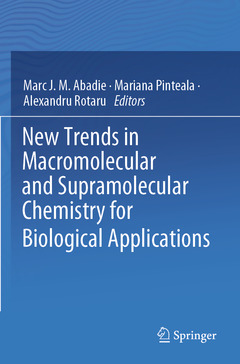o Chapter 1. Dynamic interactive systems for constitutional water and ion nano-channels
o Chapter 2. DNA transfection & Gene therapy
o Chapter 3. Drug delivery : rotaxanes & polyrotaxanes, Smart polymeric materials
o Chapter 4. New core-shell for active drug delivery : Magnetic nano-particles, CNTs, MOFs
o Chapter 5. Hydrogels for tissue engineering based on G-quartet, Chitosan & various monoaldehydeso Chapter 6. Tissue engineering
o Chapter 7. Modelisation and computitional chemistry
-1) Simon Webb, University of Manchester, UK - Approaches Towards Synthetic Signal Transduction in Phospholipid Bilayers
-2) Julien Boudon, Fadoua Sallem, Alexis Loiseau, Lionel Maurizi, Anne-Laure Papa, Nadine Millot, University of Bourgogne-Franche Conté, France - Development of Novel Versatile Theranostic Platforms Based on Titanate Nanotubes: Towards Safe Nanocarriers for Biomedical Applications
-3) Christoph Janiak, University of Dusseldorf, Germany - Metal-organic Framework—Polymer Mixed-Matrix Membranes
-4) Marc Baaden, Institut de Biologie Physico-Chimique, University of Paris, France - Insights into Adaptive Selforganized Supramolecular Structures from Molecular Modeling and Visualization
-5) Angela Casini, Technical University of Munich, German - Self-Assembled Metallacages as Drug Delivery Systems: Design Concepts and Challenge
-6) Alex Palma-Cando*, YachayTech University, Ecuador, and Ullrich Scherf, Bergische Universität Wuppertal, Germany - Functional Microporous Polymer Networks: Synthesis and Applications
-7) Claudiu T. Supuran*, University of Florence, Italy - A Story on Carbon Dioxide and its Hydration
-8) Aatto Laaksonen, Stockholm University, Sweden - Inverse Design and Hierarchical Multiscale Modelling of Biological Matter
-9) Kurt Vesterager Gothelf, iNANO, Aarhus University, Denmark - DNA-Directed Self-assembly of Macromolecular Structures
-10) Luisa De Cola, Institute de Science et d'Ingénierie Supramoléculaires (I.S.I.S.), University of Strasbourg, France and KIT, Germany - Luminescent Complexes and their Assemblies : from Understanding to Artificial Virus
-11) Ulrich S. Schubert, Friedrich Schiller University Jena, Germany - Tailor-Made Polymers and Nanoparticles for Applications in Nanomedicine
-12) Sinda Lepetre-Mouelhi, Institut Galien, University Paris-Saclay, France - Squalene-based Nanomedicines : An Original and Efficient Approach for the Treatment of Neurological Disorders without Crossing the Blood-Brain Barrier
-13) Sylvia Wagner, Fraunhofer Institute for Biomedical Engineering IBMT
Sulzbach, Germany - Biodegradable Nanoparticles for Specific Drug Transport
-14) Stephane P Vincent, University of Namur, Belgium – Multivalent rotaxanes designed as antibiofilm agents
SupraChem Lab, Iasi, RO
-15) Mihaela Silion, Adina Coroaba, Radu Zonda, Sorin Ibanescu, Mariana Pinteala, Marc Abadie - Measuring Ionic Transport through Lipid Bilayers
-16) Lilia Clima, Mariana Pinteala & Co - Polymeric Carriers for Transporting Nucleic Acids - Contributions to the Field
-17) Gheorghe Fundueanu, Sanda Bucatariu, Marieta Constantin - Smart Polymeric Materials for Drug Delivery
-18) Alexandru Rotaru, Laura Rusu, Mariana Pinteala & CO - Supramolecular Guanosine-quadruplex Hydrogels and Hydrogel Composites for Cell Growth Applications
-19) Marin Luminita & CO - Hydrogelation of Chitosan with Monoaldehydes towards Biomaterials with Tuned Properties
-20) Adrian Fifere, Mariana Pinteala & CO - Inorganic Nanoarticles as Free Radical Scavengers
-21) Rosca Irina - A Microbiological Epilogue - Nosocomial Infections
-22) Andrei Neamtu, Cornel Cojocaru - Molecular Dynamic Simulations and In Silico Analysis of Supramolecular Self-Assembled Structures
-23) Dragos Peptanariu, Lilia Clima - Validation of the Non Toxicity of Non Viral Genetic
-24) Adina Coroaba, Mariana Pinteala, Marc Abadie - Kinetics Transport of Ions/Water Through Nano-Scale Channels : Review And Update




